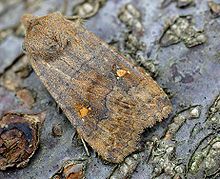| Satellite | |
|---|---|

| |
| Scientific classification | |
| Domain: | Eukaryota |
| Kingdom: | Animalia |
| Phylum: | Arthropoda |
| Class: | Insecta |
| Order: | Lepidoptera |
| Superfamily: | Noctuoidea |
| Family: | Noctuidae |
| Genus: | Eupsilia |
| Species: | E. transversa |
| Binomial name | |
| Eupsilia transversa (Hufnagel, 1766) | |
Eupsilia transversa, the satellite, is a moth of the family Noctuidae. The species was first described by Johann Siegfried Hufnagel in 1766. It is distributed throughout the Palearctic.


This is a fairly variable species with greyish or reddish-brown forewings, often marked with darker bands. The common name derives from the prominent stigma ranging in colour from white or yellow to red, which has two smaller spots close to it, appearing to be in orbit. The hindwings are brown with a paler fringe. The wingspan is 40–48 mm. This species flies at night from September to April and is active on mild nights throughout the winter. It will come to light but is more strongly attracted to sugar and various flowers.
Distribution
The species ranges from Ireland to Japan. Specifically, south to northern Spain, Sardinia, central Italy then North Macedonia, Bulgaria, Asia Minor and the Caucasus east to Central Asia and the Russian Far East and Siberia before reaching Japan. In the north, the geographical presence extends to Scotland and the Orkney Islands. Individuals have been reported in Iceland. In Fennoscandia, the range extends close to the Arctic Circle and includes northern Russia. The species is very tolerant to cold temperatures and has a very varied habitat – including open grasslands, forests, mountains (up to 1800 m in the Alps), and subarctic tundra.
Technical description and variation
For a key to the terms used, see Glossary of entomology terms.Forewing grey brown, with deeper suffusion; inner and outer lines fine, and more or less erect, the inner straight, the outer waved; a bent median shade, one before the inner line, and another close beyond the outer; submarginal line pale, interrupted, preceded and followed by dark shades; claviform and orbicular stigmata obsolete; reniform in the type form orange yellow, with a white dot above and below it; fringe concolorous, preceded by pale marginal lunules; hindwing fuscous brown. Linne's type form, showing a yellow reniform with two white dots, especially in combination with the grey-brown ground colour, is decidedly rare; as a rule, when the reniform is yellow, the tendency is for the upper, and often the lower also, of the two dots to become yellow also; when all three spots are deep reddish orange we have the form brunnea Lampa; albipuncta Strand is the form with white reniform, in which the dots also are always white; the term rufescens Tutt, in which the ground colour is more or less rufous tinged, would apply to the more ordinary European form as well as to the British.
Biology
The larva usually feeds on trees and shrubs (see list below) but has also been recorded on dandelions and also frequently eats the larvae of other species.
Recorded food plants
- Acer – maple
- Amelanchier
- Betula – birch
- Castanea – chestnut
- Corylus – common hazel
- Crataegus – hawthorn
- Filipendula – meadowsweets
- Fraxinus – European ash
- Lonicera – honeysuckle
- Malus – apple
- Prunus
- Pyrus – pear
- Quercus – oak
- Ribes – redcurrant
- Rubus
- Salix – willow
- Sorbus – rowan
- Taraxacum – dandelion
- Tilia – lime
- Ulmus – elm
- viburnum – guelder-rose
See Robinson, G. S. et al.
Notes
- The flight season refers to the British Isles. This may vary in other parts of the range.
References
- Seitz, A. Ed., 1914 Die Großschmetterlinge der Erde, Verlag Alfred Kernen, Stuttgart Band 3: Abt. 1, Die Großschmetterlinge des palaearktischen Faunengebietes, Die palaearktischen eulenartigen Nachtfalter, 1914
- Kimber, Ian. "73.210 BF2256 The Satellite Eupsilia transversa (Hufnagel, 1766)". UKMoths. Retrieved 5 July 2019.
- Robinson, Gaden S.; Ackery, Phillip R.; Kitching, Ian J.; Beccaloni, George W.; Hernández, Luis M. (2010). "Search the database - introduction and help". HOSTS - A Database of the World's Lepidopteran Hostplants. Natural History Museum, London.
- Chinery, Michael (1986, reprinted 1991). Collins Guide to the Insects of Britain and Western Europe.
- Skinner, Bernard (1984). The Colour Identification Guide to Moths of the British Isles.
External links
- Savela, Markku. "Eupsilia transversa (Hufnagel, 1766)". Lepidoptera and Some Other Life Forms. Retrieved July 5, 2019. Taxonomy
- Colour Atlas Of Siberian Lepidoptera
- Lepiforum e.V.
| Taxon identifiers | |
|---|---|
| Eupsilia transversa |
|